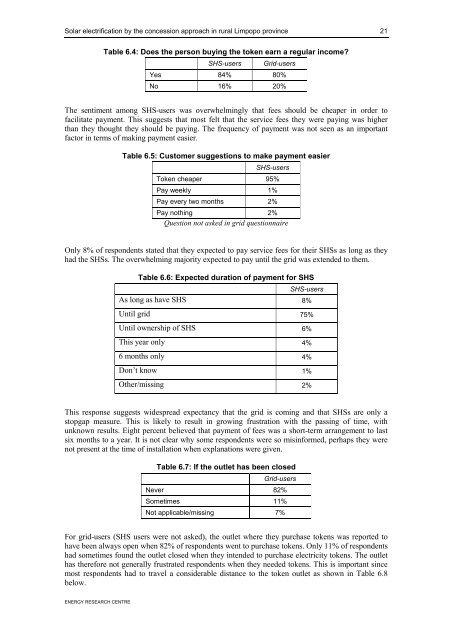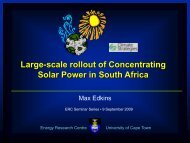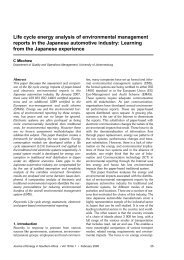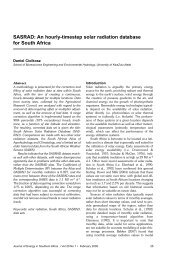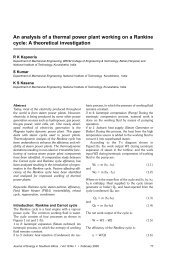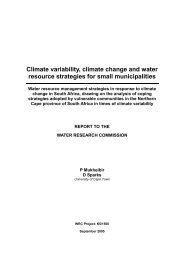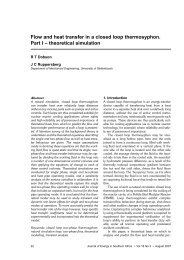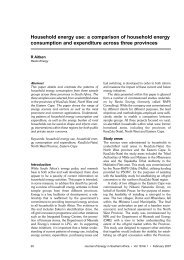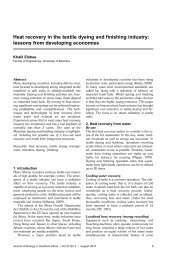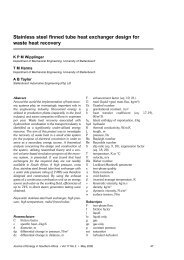Solar electrification by the concession approach in rural Limpopo ...
Solar electrification by the concession approach in rural Limpopo ...
Solar electrification by the concession approach in rural Limpopo ...
Create successful ePaper yourself
Turn your PDF publications into a flip-book with our unique Google optimized e-Paper software.
<strong>Solar</strong> <strong>electrification</strong> <strong>by</strong> <strong>the</strong> <strong>concession</strong> <strong>approach</strong> <strong>in</strong> <strong>rural</strong> <strong>Limpopo</strong> prov<strong>in</strong>ce 21Table 6.4: Does <strong>the</strong> person buy<strong>in</strong>g <strong>the</strong> token earn a regular <strong>in</strong>come?SHS-users Grid-usersYes 84% 80%No 16% 20%The sentiment among SHS-users was overwhelm<strong>in</strong>gly that fees should be cheaper <strong>in</strong> order tofacilitate payment. This suggests that most felt that <strong>the</strong> service fees <strong>the</strong>y were pay<strong>in</strong>g was higherthan <strong>the</strong>y thought <strong>the</strong>y should be pay<strong>in</strong>g. The frequency of payment was not seen as an importantfactor <strong>in</strong> terms of mak<strong>in</strong>g payment easier.Table 6.5: Customer suggestions to make payment easierSHS-usersToken cheaper 95%Pay weekly 1%Pay every two months 2%Pay noth<strong>in</strong>g 2%Question not asked <strong>in</strong> grid questionnaireOnly 8% of respondents stated that <strong>the</strong>y expected to pay service fees for <strong>the</strong>ir SHSs as long as <strong>the</strong>yhad <strong>the</strong> SHSs. The overwhelm<strong>in</strong>g majority expected to pay until <strong>the</strong> grid was extended to <strong>the</strong>m.Table 6.6: Expected duration of payment for SHSSHS-usersAs long as have SHS 8%Until grid 75%Until ownership of SHS 6%This year only 4%6 months only 4%Don’t know 1%O<strong>the</strong>r/miss<strong>in</strong>g 2%This response suggests widespread expectancy that <strong>the</strong> grid is com<strong>in</strong>g and that SHSs are only astopgap measure. This is likely to result <strong>in</strong> grow<strong>in</strong>g frustration with <strong>the</strong> pass<strong>in</strong>g of time, withunknown results. Eight percent believed that payment of fees was a short-term arrangement to lastsix months to a year. It is not clear why some respondents were so mis<strong>in</strong>formed, perhaps <strong>the</strong>y werenot present at <strong>the</strong> time of <strong>in</strong>stallation when explanations were given.Table 6.7: If <strong>the</strong> outlet has been closedGrid-usersNever 82%Sometimes 11%Not applicable/miss<strong>in</strong>g 7%For grid-users (SHS users were not asked), <strong>the</strong> outlet where <strong>the</strong>y purchase tokens was reported tohave been always open when 82% of respondents went to purchase tokens. Only 11% of respondentshad sometimes found <strong>the</strong> outlet closed when <strong>the</strong>y <strong>in</strong>tended to purchase electricity tokens. The outlethas <strong>the</strong>refore not generally frustrated respondents when <strong>the</strong>y needed tokens. This is important s<strong>in</strong>cemost respondents had to travel a considerable distance to <strong>the</strong> token outlet as shown <strong>in</strong> Table 6.8below.ENERGY RESEARCH CENTRE


